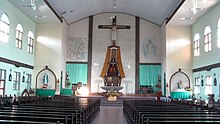Rantepao
| Rantepao | ||
|---|---|---|
|
|
||
| Coordinates | 2 ° 58 ′ S , 119 ° 54 ′ E | |
| Basic data | ||
| Country | Indonesia | |
|
Geographical unit |
Sulawesi | |
| province | Sulawesi Selatan | |
| ISO 3166-2 | ID-SN | |
| Kabupaten | North Toraya | |
| Residents | 43,123 (2010) | |
|
Event center in Rantepao
|
||
Rantepao is an Indonesian city on the island of Sulawesi . It is the capital of the Northern Toraja administrative district ( Toraja Utara ) and the cultural center of the Toraja ethnic group .
location and size
Rantepao has 43,123 inhabitants (2010 calculation) and is located in the Tana Toraja highlands, around 300 km northeast of Makassar. The Sa'dan flows through the city .
Economy and Transport
Rantepao is the commercial, cultural and service center of the Tana Toraja highlands. The city is connected to Makassar by a good road that is passable in all weather conditions and has become the starting point for visiting the region after it was opened to tourism in the 1970s. Pongtiku airfield around 30 km southwest of Rantepao, from which there is a flight connection to Makassar three times a week, is currently being expanded to enable a direct connection to Singapore to promote tourism. However, to this day Rantepao does not have a central bus station - the intercity buses start and end in front of the offices of the respective bus company.
Infrastructure
As the district capital, Rantepao has numerous authorities, schools and an important hospital. In the city center, an event center was built in the traditional architectural style of the Toraja. On the outskirts there is a regular cattle market ( Pasar Bolu ), where buffalo and pigs in particular are traded - both animals are of outstanding importance in the culture of the very traditional Toraja.
Since the highlands of Tana Toraja are also a popular destination for foreign travelers, a good tourist infrastructure has developed in Rantepao by Indonesian standards. There are several accommodation establishments for travelers throughout the city, and not just on the city's two main shopping streets, Jalan A. Mappanyuki and Jalan Jen. A. Yani, you will find restaurants and numerous shops of all kinds.
architecture
The city is the cultural center of the mostly Protestant Toraja and therefore, in contrast to comparable cities in Indonesia, is characterized by several church buildings. In the city center, the event center and several administrative buildings of the city and church type were built in the traditional style of a Tongkonan house with a curved roof typical of Toraja architecture. From a distance, these roofs resemble boats and are reminiscent of an old legend according to which the ancestors of the Toraja once came to Sulawesi by sea and initially lived under their boats turned upside down in the absence of adequate housing. The interior of the Catholic Santa Theresia Church, construction of which began in 1989, also draws on traditional stylistic elements of the Torayan culture.
A monument was erected in front of the most important Protestant church to commemorate the introduction of the Bible in 1913. Another striking monument with a height of 10 m, which shows the freedom fighter Pong Tiku on a horse, is located in the central market. This is exactly where Pong Tiku, who had rebelled against the Dutch colonial rulers with an army from Toraja, was executed in 1907.
Surroundings
In the vicinity of Rantepao there are numerous places worth visiting, some of which are related to the distinctive burial and death cult of the Toraja.
In the village of Ke'te Kesu, south of Rantepao, where five well-preserved Tongkonan houses and over ten rice granaries built on stilts can be seen, a cave with numerous graves is much visited.
The village of Kambira about 10 km south of Rantepao is known for an old tree, in the massive trunk of which until about 100 years ago children who had no teeth were buried - according to the religious ideas of the Toraja, it was believed that they would be in the tree live on.
Londa, a village 7 km southwest of Rantepao, is well visited because of a cave in a rock wall, where graves and wooden coffins and human bones in rock niches can also be seen. At another rock, a footpath leads past several coffins and buildings that are reminiscent of Christian chapels, up to a height of about 60 m. In front of several graves, figures made of wood, which are called by the Toraja Tao Tao and commemorate the deceased, were placed. Some of these figures are almost life-size and were designed by the artists to resemble the deceased in terms of face, hairstyle and stature. Some of the figures were put on the clothes of the deceased.
A pond in the forest near Tilanga is often used for bathing.
The village of Lemo is much visited because of a rock wall in which there are burial niches at a great height with Tao Tao figures in front of it.
Web links
Individual evidence
- ↑ Page no longer available , search in web archives: Indonesia: The most important places with statistics on their population. World Gazetteer
- ↑ Nurul Noe: Makassar dan sekitarnya , p. 54. Jakarta 2014
- ↑ Stefan Loose: Indonesia from Sumatra to Sulawesi , p. 579. Ostfildern 2013
- ↑ Nurul Noe: Makassar dan sekitarnya , p. 60. Jakarta 2014
- ↑ Nurul Noe: Makassar dan sekitarnya , p. 68. Jakarta 2014
- ↑ Nurul Noe: Makassar dan sekitarnya , p. 62. Jakarta 2014
- ↑ Nurul Noe: Makassar dan sekitarnya , p. 64. Jakarta 2014
- ↑ Nurul Noe: Makassar dan sekitarnya , p. 65. Jakarta 2014




